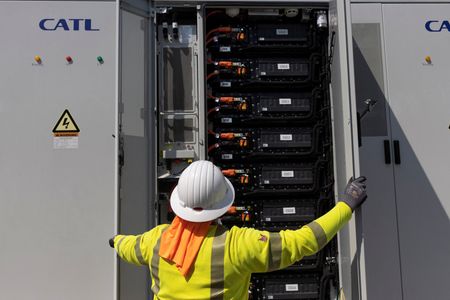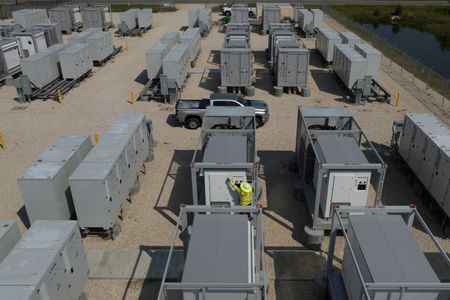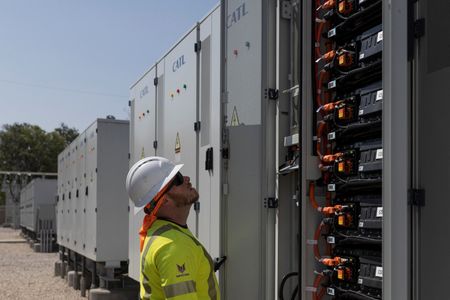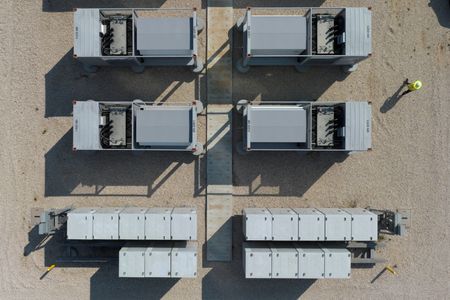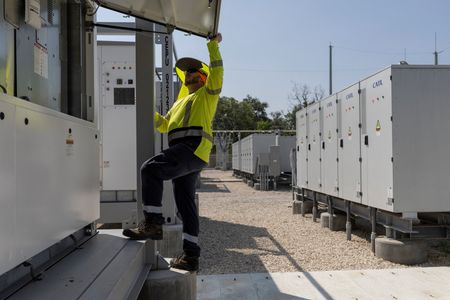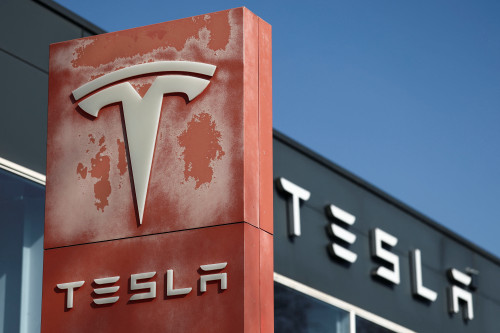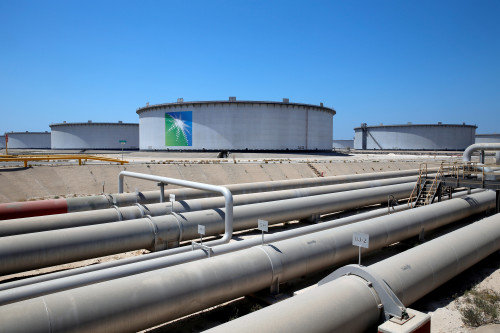By Nichola Groom and Laila Kearney
(Reuters) -BlackRock, Korea’s SK, Switzerland’s UBS and other companies are chasing an investment boom in battery storage plants in Texas, lured by the prospect of earning double-digit returns from the power grid problems plaguing the state, according to project owners, developers and suppliers.
Projects coming online are generating returns of around 20%, compared with single digit returns for solar and wind projects, according to Rhett Bennett, CEO of Black Mountain Energy Storage, one of the top developers in the state.
“Resolving grid issues with utility-scale energy storage is probably the hottest thing out there,” he said.
The rapid expansion of battery storage could help prevent a repeat of the February 2021 ice storm and grid collapse which killed 246 people and left millions of Texans without power for days.
The battery rush also puts the Republican-controlled state at the forefront of President Joe Biden’s push to expand renewable energy use.
Reuters drew on previously unreported data and interviewed more than a dozen executives from private equity firms, utility companies and energy storage providers involved in some of the biggest battery storage deals for this report. They described a rush to take advantage of the high returns before they erode.
Power prices in Texas can swing from highs of about $90 per megawatt hour (MWh) on a normal summer day to nearly $3,000 per MWh when demand surges on a day with less wind power, according to a simulation by the federal government’s U.S. Energy Information Administration.
That volatility, a product of demand and higher reliance on intermittent wind and solar energy, has fueled a rush to install battery plants that store electricity when it is cheap and abundant and sell when supplies tighten and prices soar.
Texas last year accounted for 31% of new U.S. grid-scale energy storage, according to energy research firm Wood Mackenzie, second only to California which has had a state mandate for battery development for a decade.
LEADER IN ENERGY STORAGE
And Texas is expected to account for nearly a quarter of the U.S. grid-scale storage market over the next five years, according to Wood Mackenzie projections shared with Reuters.
Developers and energy traders said locations offering the highest returns — in strapped areas of the grid — will become increasingly scarce as more storage comes online and electricity prices stabilize.
Texas lawmakers this week voted to provide new subsidies for natural gas power plants in a bid to shore up reliability. But the legislation also contains provisions that industry groups said could encourage investment in battery storage.
Amid the battery rush, BlackRock acquired developer Jupiter Power from private equity firm EnCap Investments late last year. Korea’s SK E&S acquired Key Capture Energy from Vision Ridge Partners in 2021 and UBS bought five Texas projects from Black Mountain last year for a combined 700 megawatts (MW) of energy storage. None of the sales’ prices were disclosed.
SK E&S said its acquisition of Key Capture was part of a strategy to invest in U.S. grid resiliency.
“SK E&S views energy storage solutions in Texas and across the U.S. as a core technology that supports a new energy infrastructure system to ensure American homes and businesses have affordable power,” the company said in a statement.
UBS and BlackRock declined to comment.
U.S. energy storage companies attracted $5.5 billion in investment last year, according to Mercom Capital Group. The U.S. is projected to install 65 gigawatts (GW) of grid storage over the next five years, 15 times the 4 GW added last year, according to Wood Mackenzie, buoyed by a 30% tax credit for energy storage in Biden’s Inflation Reduction Act (IRA).
The Electric Reliability Council of Texas (ERCOT), which operates the grid that serves most of the state, has 3.2 GW of energy storage capacity, according to its own data.
The authority said in a statement that more storage was in development. It has pending requests to connect to the grid from plants offering more than 96 GW in storage, according to ERCOT data. ERCOT declined an interview request.
‘CLOAK AND DAGGER’
“It’s cheaper to build there, the revenue is higher, and the problems are real,” said Andrew Waranch, president of Spearmint Energy, which acquired about 1 GW of Texas projects in the last year.
While some investors have focused on specific locations with maximum volatility, more than 80% of the revenue comes from the Ancillary Services Market, which seeks to stabilize power supply across the grid, according to David Miller, vice president of business development at Gridmatic, which uses artificial intelligence to optimize battery use.
Miller said he expects ancillary market prices to “collapse” as more battery storage comes online.
Average energy storage revenue already fell about 18% last year, according to a Gridmatic analysis.
Waranch said battery storage plants coming online in 2025 could take up to eight years to break even compared with four or less for plants that come online in 2023.
The urgency has helped fuel a rush to install projects that can get faster regulatory clearance.
Stem Inc and other developers said they are focusing on small projects of under 10 MW because they face fewer regulatory requirements.
The diminishing returns have also intensified competition for sites in areas with the wildest wholesale power price fluctuations, industry executives said.
“We want to get maximum volatility,” said American Enerpower Chairman Dick Lewis, who scours Texas for plots of land near constrained parts of the grid to develop battery plants. “Placement is very important.”
So is timing, said Andrew Tang, vice president of energy storage and optimization at Finland’s Wartsila, which has supplied about a third of the Texas battery market.
“There’s a little bit of cloak and dagger secrecy,” he said. “If they think they’ve seen a trading opportunity that exists in the marketplace, they don’t want to openly brag about it because someone else will jump in and therefore get rid of the arbitrage opportunity,” he said.
Chris McKissack, CEO of storage developer GlidePath, said that batteries will likely remain a good bet for a long time — even if Texas is seeking to bolster traditional forms of energy like natural gas.
“If no new generation is built and all you’ve got is old generation and load growth, you’ve got even more volatility,” McKissack said. And that, he said, could lead to more opportunity for storage.
(Reporting by Nichola Groom and Laila Kearney; Editing by Richard Valdmanis and Suzanne Goldenberg)

